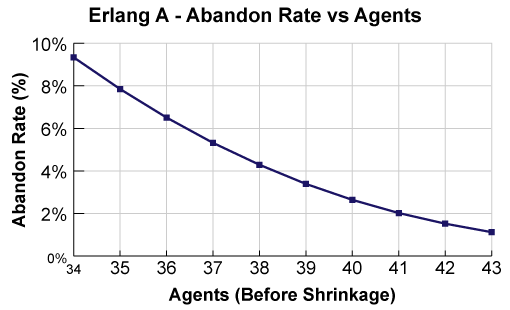Staffing a contact centre isn’t just about predicting how many calls you’ll get—it’s also about anticipating how long customers are willing to wait. That’s where the Erlang A formula comes in.
While many workforce planners are familiar with Erlang C, which helps calculate staffing needs based on call volume and service levels, Erlang A is very useful in helping you to predict the number of abandoned calls in the contact centre.
In this beginners guide, we’ll break down what Erlang A is, how it differs from other Erlang models, and why it’s so valuable in creating more accurate forecasts and better customer experiences.
But, before we start, it is first helpful to take you through each of the three Erlang formulas.
The ABC of Erlang
Three Erlang formulas were devised in the first half of the 20th century: Erlang A, Erlang B and Erlang C.
However, these formulas were not created in that order, with Erlang B being the first to be invented by a Danish mathematician named AK Erlang.
In 1917, AK Erlang followed this up by creating the Erlang C formula, before another mathematician, named Conny Palm, then invented the Erlang A formula in 1946.
While the Erlang B formula isn’t really used within contact centre today, both Erlang C and Erlang A still have a huge part to play in contact centre workforce management (WFM).
The Erlang B Formula
Originally, the Erlang B formula was designed to work out the probability of blocking within a phone system.
So, when contact centres were first introduced, Erlang B was used to calculate how many lines you required in a contact centre to allow for queuing.
Therefore, inputs into Erlang B when applied to the contact centre would include forecast call volumes and Average Handle Time (AHT) to calculate how quickly the queue would move on average. That number would influence the number of phone lines you’d need.
The Erlang C Formula
The Erlang C formula, built upon the Erlang B formula, is used in the contact centre to work out how many advisors you need to staff the contact centre to meet a given service level. This is a formula that’s still very much used within the industry.
The formula is encoded into devices known as “Erlang Calculators“, which make contact centre staffing calculations easy.
To do this, the Erlang Calculator converts a number of calls, AHT and service level into a number of staff required, while modern versions also take other metrics – such as occupancy, shrinkage and average patience – into consideration as well.
However, to calculate average patience, you’re also going to need a little help from Erlang A…
The Erlang A Formula
The Erlang C formula, while it was very useful, didn’t take into account the number of people who abandon their calls before they reach an advisor.
Fortunately, in 1946, Swedish mathematician Conny Palm devised an extension of the Erlang C formula, which is known as the Erlang A formula, which does take “Abandons” into account. In fact, the A in Erlang A stands for Abandons.

In creating the Erlang A formula, Palm used a simple, manageable way to measure abandons that combines the mathematics of both AK Erlang and Andrey Markov.
The Erlang A formula is highlighted below:

Erlang A Derives From Markov Theories as Well as Erlang B & C
While being an extension of Erlang B and C, the Erlang A formula takes into account the “birth and death” process, theorised by Russian mathematician Andrey Markov.
This was then interpreted by Conny Palm into his Erlang A formula, with a “birth” being people joining the queue and a “death” being people abandoning the queue, making Markov’s theory the basis of the formula.
The Importance of Average Patience for Erlang A
By merging the mathematics of AK Erlang and Andrey Markov, Palm’s Erlang A equation proved a great method of predicting caller “abandons”.
The major difference is that as well as a service level, you also need to include an average patience.
Average patience is the rate at which 50% of people will abandon, which you can quite easily calculate in your contact centre by plotting the percentage of abandoned calls against time – using data from within your ACD system.

Depending on the type of contact centre you are, whether that’s sales or technical support, average patience will be different, due to differences in your customers’ intent and their willingness to wait.
Why Not Just Use Erlang A and Not Erlang C for Staffing Calculations?
While Erlang A is good at estimating the number of abandoned calls based on average patience, it has a tendency to underestimate the number of staff that are needed.
For example, if 50 people were to call in and the Erlang A predicts that 10 will abandon – if you just use the Erlang A formula, you will only staff for 40 people.
However, there will be some days when fewer or more than 10 people abandon, as natural variation is a given. So, if it’s a day where it’s fewer than 10 people, you will likely be understaffed.
When you are understaffed, you’re unlikely to ever recover as you are always running behind schedule. If you instead plan to always be a little bit ahead of the curve, you then have the ability to catch up.
Because of this, it’s important not to use the Erlang A formula alone in working out how many people you need to staff the contact centre at any one time based on a service level.
So, by combining Erlang C and Erlang A, you can receive the most accurate prediction for how many staff are needed, in accordance with your:
- Forecast contact volumes
- Average Handling Time (AHT)
- Service level
- Occupancy
- Shrinkage
- Average patience
Erlang Calculations
To showcase how both the Erlang A and the Erlang C formula can work together, here is an example of how our Erlang Calculator produces its staffing calculations.
With the estimated number of advisors needed being based on Erlang C and the abandon rate being based on Erlang A, we will enter the following information into the Erlang Calculator.
- Forecast contact volumes – 100 contacts
- In a time period of – 30 mins
- Average Handling Time (AHT) – 157 seconds
- Service level – 80% of calls answered in 20 seconds
- Occupancy – 85%
- Shrinkage – 30%
- Average patience – 90%


From these calculations, Erlang C is telling us that we need 17 advisors in the contact centre for this 30-minute period.
Meanwhile, Erlang A is predicting that if we staff to have 17 advisors across this 30-minute time period, our abandon rate would be 3.41%.
But if your contact centre prides itself on excellent customer service, you may want to set an “abandon ceiling” of 3% – i.e. you want to ensure that no more than 3% of your customers abandon.
To do this, we can look once more at the table and realise that Erlang A is telling us that if we have 18 advisors within the contact centre, our abandon rate would be highly unlikely to surpass 3%.
So, if your contact centre sets an abandon ceiling of 3%, you’d staff for 18 advisors and not 17.
For a full guide into how to use the Erlang Calculator and gather all of the data required, read our article: How to Work Out How Many Staff You Need in a Contact Centre
The Erlang C equation doesn’t take into account abandoned calls, which means that the equation alone doesn’t produce the most accurate results. Luckily, the Erlang A formula can do this.
To calculate average patience, create an abandon curve by plotting abandon rates against time to find the time when 50% of your callers will abandon.
Insert this figure into your Erlang calculations and you’ll receive both an estimate for the number of staff required and an estimated abandon rate.
To find out more about using the Erlang formulas in the contact centre, read our articles:
- Erlang C Formula – Made Simple With an Easy Worked Example
- 10 Things You Need When Calculating How Many Contact Centre Advisors You Need
- What Is Workforce Management (WFM)?
Author: Jonty Pearce
Reviewed by: Megan Jones
Published On: 20th May 2019 - Last modified: 13th Nov 2025
Read more about - Erlang, Erlang Calculations, Staffing, Workforce Management (WFM), Workforce Planning







































